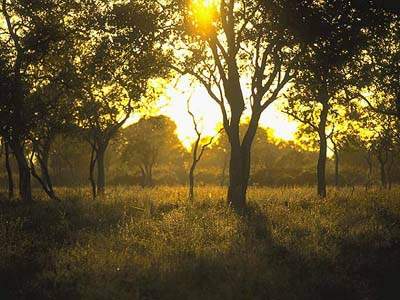
The Incredible Biodiversity of Africa
When we think of biodiversity, we see Africa where biodiversity is at its best!
Ernest Hemingway once wrote, "I never knew of a morning in Africa when I woke up and wasn't happy." What do you think Hemingway meant by that? We knew of the famous hunts and trophies, not to mention what would end up being his inspiration for his books involving his first of many visits to Africa. In "The Snows of Kilimanjaro," Hemingway referenced a frozen leopard carcass he found while on his trek, with no answer of what the leopard was hunting for at that altitude. This is what makes Africa so wonderful; BIODIVERSITY! Leopards, for example, exist mainly in equatorial climate regions, which include the base of Kilimanjaro, but what was the leopard, that Hemingway made famous, hunting for at such a high altitude that it couldn't hunt in its own ecosystem? This in itself remains a mystery, but it brings up the many ecosystems that make up the beauty of Africa, which is what I believe to be at the heart of Hemingway's quote.
All the living species in a given area or environment, whether it be cold, hot, wet, dry, high, low, forested or bare, is an ecosystem and Africa has eight (8) major ones including:
- Desert
- Gallery Forest
- Montane
- River
- Savanna
- Tropical Forest
- Wetland
- Woodland
Named Ecosystems
- The Sahara
Did you know that the entire area of the Sahara is comparable to that of the United States? That's how vast The Sahara, not to mention Africa really is. In terms of temperature, the Sahara has an average high that exceeds 104 degrees Fahrenheit on a daily basis. Rainfall is literally nonexistent around the central and eastern part of The Sahara. So, what types of species of mammal, reptile, insect, and plant life can survive in such a dry, hot, and desolate ecosystem? It will surprise you to know that several known species survive the harsh rigors of this desolate ecosystem, daily. A list of most of these species would include pale fox, Ruppell's fox, the addax, Dorcas gazelle, monitor lizard, sand viper, red-necked ostrich, deathstalker scorpion, Saharan silver ant, dromedary camel and a few more.
- The Serengeti
The Serengeti, an ecosystem that stretches 12,000 miles from Tanzania to Kenya is what African Safaris are known for today. Every year, a migration larger than any other known begins like clockwork between approximately May and August from Tanzania to Kenya. The end result is Darwinian at its most primitive state! The Great Migration consists of over 1 million wildebeest, over 200,000 zebras and antelopes traveling from one end of the Serengeti to the other in order to graze. Unfortunately, about 20% don't make it back.
Rising almost four miles above the northern border of Tanzania, Mount Kilimanjaro is not only the highest volcano in Africa, but also the highest outside South America. Although Charles New was the first person to reach 13,000 feet on his first attempt in 1871, ten years earlier, Barron Karl Klaus von der Decken was the first to attempt it. That's often considered secondary to the miraculous life that exists upon the million-year-old stratovolcano! Kilimanjaro is made up of five (5) zones:
- Zone 1 - Bushland (Elevation: 2,625 & 5,900 feet)
- Zone 2 - Rainforest (Elevation: 5,906 & 9,186 feet): Kilimanjaro's Rain Forest. Over 90% of Kilimanjaro's water comes from this area. It is also where most of the volcano's smaller animals and vegetation can be found.
- Zone 3 - Heath (Elevation: 13,000 feet): occupied by larger species of animals such as elephants, leopards, and the Cape Buffalo. This means that the leopard Hemingway mentioned in his book may have been on zone 4 or Alpine Desert, which is at an elevation of over 16,000 feet, where it's incredibly difficult for wildlife to survive.
- Zone 4 - Alpine Desert (Elevation: 16,400 feet): with exception to bugs, it is incredibly difficult for anything larger than a bug to survive in such an extreme environment. The temperatures themselves are extreme with highs of over 106 degrees Fahrenheit and lows clocked in at under 30 degrees Fahrenheit.
- Zone 5 - The Apex or Arctic Zone: is at the top-most area, which is not only desolate but brutal. The conditions alone will not allow any vegetation or animal life to grow or survive.
- The Congo (Tropical Forest & River)
The Democratic Republic of the Congo is by far the most biodiverse country in all of Africa! The rainforests alone accommodate some of the rarest animal species, such as the Great Ape, numbered only around 200,000 (while once were over a million in total population). Bonobos, Chimpanzees, and Gorillas are considered endangered. The African Forest Elephant and White Rhino are another two species of animal that reside within The Congos' rainforests. Some of the major ecosystems the Congo has are rivers, forests, savanna, swamps, and flooded forests.
- Okavango Delta (Botswana)
Imagine an area of water that spreads over 3,700 miles and with enough water can swell upwards of 9,000 miles. This is the Okavango Delta! At its largest, the Okavango Delta trumps the Mississippi River Delta by almost 2,000 miles. The Okavango Delta serves all sorts of species of wildlife such as birds, lions, elephants, buffalo, crocodiles, baboons, hippopotamus, and wildebeest from miles away. What many might not know about the Okavango Delta is that it was officially added to the UNESCO World Heritage List in 2014. As a result, it became the 1,000th UNESCO World Heritage site, a significant feat.
- Miombo Woodlands
Located on the Nyika Plateau in Tanzania, The Miombo Woodlands is home to not one, but four (4) ecoregions: Angolan Miombo Woodlands, Central Zambezian Miombo Woodlands, Eastern Miombo Woodlands, and Southern Miombo Woodlands.
In conclusion, based on the ecosystems and ecoregions within Africa's countries, it's easy to understand Hemingway's quote. No matter where you wake up in Africa, how could you not be happy?
